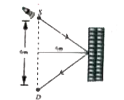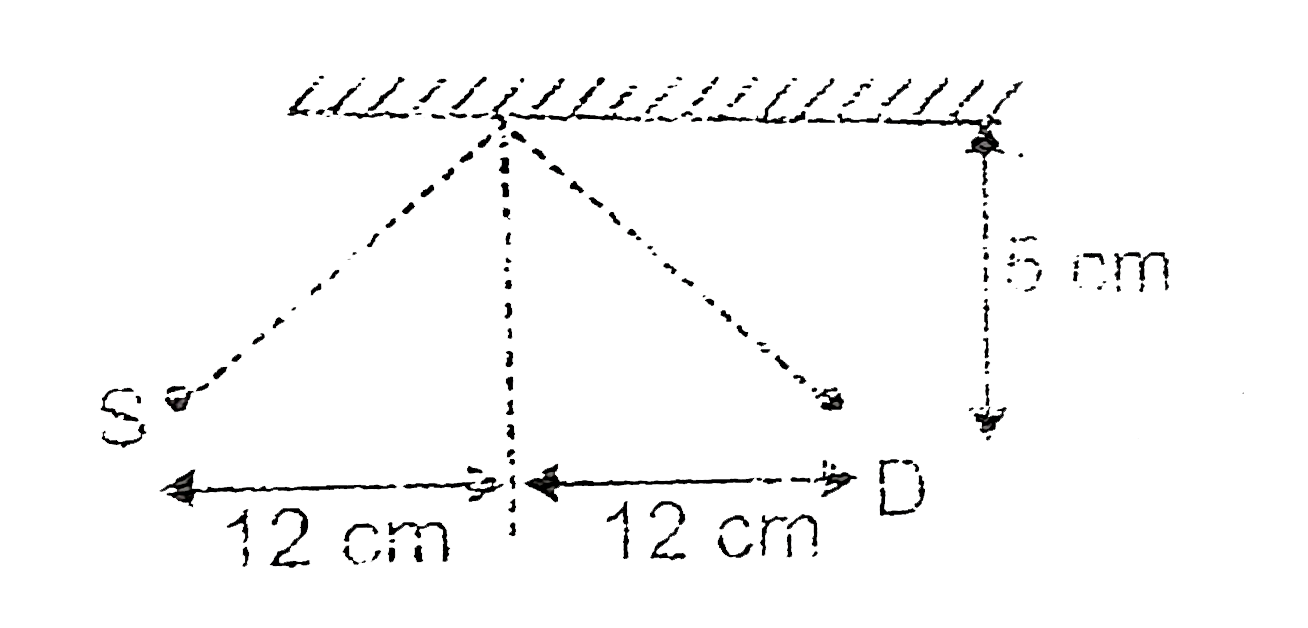In a hall, a person receives direct sound waves from a source 120m away. He also receives waves from the same source which reach him after being reflected from the 25m high ceiling at a point halfway between them. The two waves interfere constructively for wavelengths (in metres)
20,203,203, etc.
10,5,3.33, etc
10,20,30, etc
15,25,35, etc
The correct Answer is:A
To solve the problem step by step, we need to find the wavelengths for which the two sound waves interfere constructively. Here’s how we can approach this problem:
Step 1: Understand the Geometry of the Problem
We have a sound source and a person receiving sound waves. The direct sound wave travels a distance of 120 m, while the reflected sound wave travels from the source to the ceiling and then to the person. The ceiling height is 25 m.
Step 2: Determine the Path Lengths
1. The direct path (AC) is 120 m.
2. The path of the reflected wave (AB + BC) can be calculated using the right triangle formed by the height of the ceiling and the horizontal distance to the halfway point (M).
Step 3: Calculate the Distance AB
- The distance from the source to the ceiling (AB) can be calculated using the Pythagorean theorem. The horizontal distance from the source to the halfway point is half of 120 m, which is 60 m.
- Therefore, the distance AB can be calculated as:
AB=√(252)+(602)=√625+3600=√4225=65 m
Step 4: Calculate the Distance BC
- Since the path BC is the same as AB (the sound wave travels the same distance after reflecting), we have:
BC=65 m
Step 5: Calculate the Total Path Length for the Reflected Wave
- The total path length for the reflected wave (AB + BC) is:
AB+BC=65+65=130 m
Step 6: Calculate the Path Difference
- The path difference (Δ) between the two waves is given by:
Δ=(AB+BC)−AC=130−120=10 m
Step 7: Determine the Condition for Constructive Interference
- For constructive interference, the path difference must be an integral multiple of the wavelength (λ):
Δ=nλ(n=0,1,2,3,…)
- Therefore, we can write:
10=nλ
Step 8: Calculate Possible Wavelengths
- Rearranging gives:
λ=10n
- For different values of n:
- For n=1: λ=10 m
- For n=2: λ=5 m
- For n=3: λ=103≈3.33 m
Conclusion
The wavelengths for which the two waves interfere constructively are:
- λ=10 m,5 m, and 3.33 m
We have a sound source and a person receiving sound waves. The direct sound wave travels a distance of 120 m, while the reflected sound wave travels from the source to the ceiling and then to the person. The ceiling height is 25 m.
1. The direct path (AC) is 120 m.
2. The path of the reflected wave (AB + BC) can be calculated using the right triangle formed by the height of the ceiling and the horizontal distance to the halfway point (M).
- The distance from the source to the ceiling (AB) can be calculated using the Pythagorean theorem. The horizontal distance from the source to the halfway point is half of 120 m, which is 60 m.
- Therefore, the distance AB can be calculated as:
AB=√(252)+(602)=√625+3600=√4225=65 m
- Since the path BC is the same as AB (the sound wave travels the same distance after reflecting), we have:
BC=65 m
- The total path length for the reflected wave (AB + BC) is:
AB+BC=65+65=130 m
- The path difference (Δ) between the two waves is given by:
Δ=(AB+BC)−AC=130−120=10 m
- For constructive interference, the path difference must be an integral multiple of the wavelength (λ):
Δ=nλ(n=0,1,2,3,…)
- Therefore, we can write:
10=nλ
- Rearranging gives:
λ=10n
- For different values of n:
- For n=1: λ=10 m
- For n=2: λ=5 m
- For n=3: λ=103≈3.33 m
Conclusion
The wavelengths for which the two waves interfere constructively are:
- λ=10 m,5 m, and 3.33 m
Similar Questions
In a large room , a person receives direct sound waves from a source 120 metres away from him. He also receives waves from the same source which reach , being reflected from the 25m high ceiling at a point halfway between them . The two waves interfere constructively for a wavelength of
View SolutionIn a large room , a person receives direct sound waves from a source 120m away . He also receives waves from the same source which reach him after being reflected from the 5−m high ceiling at a point halfway between them . For which wavelengths will these two sound waves interfere constructively ?
View SolutionIn a large room , a person receives direct sound waves from a source 120m away . He also receives waves from the same source which reach him after being reflected from the 5m high ceiling at a point halfway between them . For which wavelengths will these two sound waves interfere constructively ?
View SolutionA detector at x=0 receives waves from three sources each of amplitude A and frequencies f+2,f and f−2.
The time at which intensity is maximum, is
View SolutionA person standing at a distance of 6 m from a source of sound receives sound wave in two ways, one directly from the source and other after reflection from a rigid boundary as shown in the figure. The maximum wavelength for which, the person will receive maximum sound intensity, is

View SolutionThe path length difference between two waves coming from coherent sources for destructive interference should be
View SolutionAn electromagnetic wave emitted by source travels 21 km to arrive at a receiver. The wave while travelling in another path is reflected from a surface at 19 km away and further travels 12 km to reach the same receiver. If destructive interference occurs at the receiving end, the mximum wavelength of the wave is
View SolutionA source S and a detector D are placed at a distance d apart. A big cardboard is placed at a distance √2d from the source and the detector as shown in figure. The source emits a wave of wavelength =d2 which is received by the detector after reflection from the cardboard. It is found to be in phase with the direct wave received from the source. By what minimum distance should the cardboard be shifted away so that the reflected wave becomes out of phase with the direct wave ?

View SolutionTwo coherent sources A and B of radio waves are 5.00 m apart. Each source emits waves with wavelength 6.00m. Consider points along the line between the two sources. At what distances, if any, from A is the interference (a) constructive (b) destructive?
View SolutionA sound source, detector and a cardboard are arranged as shown in figure. The wave is reflected from the cardboard at the line symmetry of source edetector. Initially the path difference between the reflected wave and the direct wave is one third of the wavelength of sound. Find the minimum distance by which the cardboard should be moved upwards so that both waves are in phase.

View Solution
